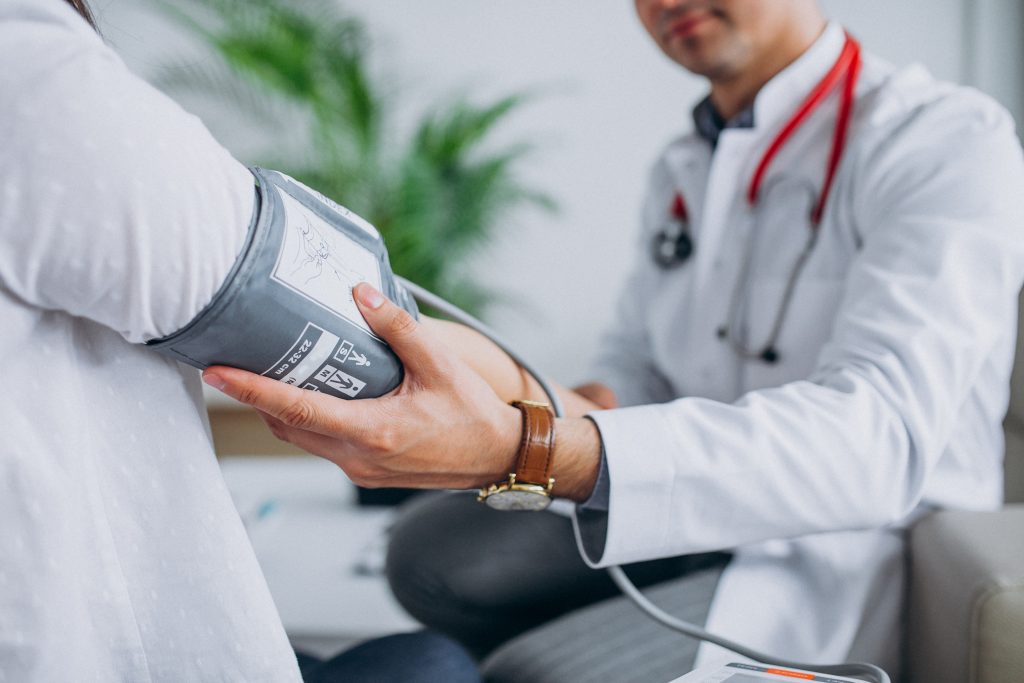Blood pressure is the force exerted by circulating blood against the walls of the body’s arteries, the major blood vessels in the body. Hypertension is when blood pressure is too high.
Blood pressure is written as two numbers. The first (systolic) number represents the pressure in blood vessels when the heart contracts or beats. The second (diastolic) number represents the pressure in the vessels when the heart rests between beats.
Hypertension is diagnosed if, when it is measured on two different days, the systolic blood pressure readings on both days is ≥140 mmHg and/or the diastolic blood pressure readings on both days is ≥90 mmHg.
Signs / Symptoms
What's common signs of hypertension?
- Headaches
- Shortness of breath
- Nosebleeds
- Irregular heart rhythms
- Vision changes
- Buzzing in the ears
- Fatigue
- Nausea
- Vomiting
- Confusion
- Anxiety
- Chest pain
- Muscle tremors
Common causes
What's common causes of hypertension?
There are two types of high blood pressure:
Primary (essential) hypertension
For most adults, there’s no identifiable cause of high blood pressure. This type of high blood pressure, called primary (essential) hypertension, tends to develop gradually over many years.
Secondary hypertension
Some people have high blood pressure caused by an underlying condition. This type of high blood pressure, called secondary hypertension, tends to appear suddenly and cause higher blood pressure than does primary hypertension. Various conditions and medications can lead to secondary hypertension, including:
- Obstructive sleep apnea
- Kidney problems
- Adrenal gland tumors
- Thyroid problems
- Certain defects you’re born with (congenital) in blood vessels
- Certain medications, such as birth control pills, cold remedies, decongestants, over-the-counter pain relievers and some prescription drugs
- Illegal drugs, such as cocaine and amphetamines
Departments & Emergency
You can go to your family physician or ,for further research, cardiology department of hospital. You’ll likely have your blood pressure taken as part of a routine doctor’s appointment.
Ask your doctor for a blood pressure reading at least every two years starting at age 18. If you’re age 40 or older, or you’re 18 to 39 with a high risk of high blood pressure, ask your doctor for a blood pressure reading every year.
Blood pressure generally should be checked in both arms to determine if there’s a difference. It’s important to use an appropriate-sized arm cuff.
Diagnosis
To measure your blood pressure, your doctor or a specialist will usually place an inflatable arm cuff around your arm and measure your blood pressure using a pressure-measuring gauge.
A blood pressure reading, given in millimeters of mercury (mm Hg), has two numbers. The first, or upper, number measures the pressure in your arteries when your heart beats (systolic pressure). The second, or lower, number measures the pressure in your arteries between beats (diastolic pressure).
Blood pressure measurements fall into four general categories:
Normal blood pressure: Your blood pressure is normal if it’s below 120/80 mm Hg.
Elevated blood pressure: Elevated blood pressure is a systolic pressure ranging from 120 to 129 mm Hg and a diastolic pressure below 80 mm Hg. Elevated blood pressure tends to get worse over time unless steps are taken to control blood pressure.
Stage 1 hypertension: Stage 1 hypertension is a systolic pressure ranging from 130 to 139 mm Hg or a diastolic pressure ranging from 80 to 89 mm Hg.
Stage 2 hypertension: More severe hypertension, stage 2 hypertension is a systolic pressure of 140 mm Hg or higher or a diastolic pressure of 90 mm Hg or higher.
You can buy a variety of low-cost monitors so you can test your blood pressure at home or while you’re out and about.
Measure your blood pressure twice a day, ideally in the morning and the evening, while you’re sitting down. Each time take 2 readings, 1 minute apart. Continue to measure your blood pressure twice a day for 7 days.
Your doctor or nurse will use this information to work out your average blood pressure. It’s important to make sure you use equipment that’s been properly tested.
Treatment
Prevention
- Reducing salt intake (to less than 5g daily)
- Eating more fruit and vegetables
- Being physically active on a regular basis
- Avoiding use of tobacco
- Reducing alcohol consumption
- Limiting the intake of foods high in saturated fats
- Eliminating/reducing trans fats in diet
Management
- Reducing and managing mental stress
- Regularly checking blood pressure
- Treating high blood pressure
- Managing other medical conditions
FAQ
What is the main cause of hypertension?
The most common causes of hypertension include smoking, obesity or being overweight, diabetes, having a sedentary lifestyle, lack of physical activity, high salt or alcohol intake levels, insufficient consumption of calcium, potassium or magnesium, a deficiency in vitamin D, stress, aging, chronic kidney disease and adrenal and thyroid conditions or tumors. Some individuals may also be genetically predisposed to hypertension.



